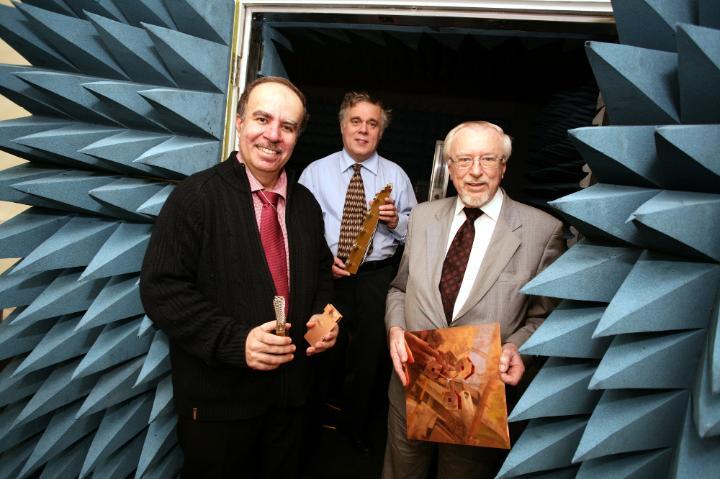Radio Frequency, Antennas, Propagation and Computational Electromagnetics Research Group
The group has over 20 years' research experience in the areas of antennas, propagation model, Radio Frequency design and electromagnetic computational techniques. The group has an impressively strong industry and academic track record, being well known through novel patent inventions and original research articles that are noticeable through profiles of the individual group members.

Achievements
- Design of novel miniaturised compact antenna for wireless communication (patented) and novel balanced antennas for mobile handsets (patented)
- Spatial correlation for N-elements lossy radiating elements (patent applied for)
- Design and Development of new antennas operate within the ground surface
- Development of code division test bed for propagation and radiation model (patented).
- Development of Radio Frequency switches for beam forming and beam steering control applications.
- Design and implementation of fully controlled RF switch systems using a microprocessor controller.
- The first development of the hybrid field computation method linking frequency-domain Method of Moments to the Finite Difference Time Domain method.
- Implementation of wide-band hybridisation techniques using interpolation of impedance matrices.
- Implementation of Genetic Algorithm method to achieve the required steerable radiation beam and/or controlling beamwidth to meet the RFID and WLAN design specifications.
- Commercial software tools, with novel aspects have been implemented through several Knowledge Transfer Programmes (KTP) projects.
Facilities and Services: Measurements and Modelling
Our research laboratories contain the latest hardware and software facilities, which have been built on the strength of research contract funding. Hardware facilities are matched by an impressive array of software packages.
Measurements facilities include:
- A 100 cubic metre microwave anechoic chamber.
- Automated measurements up to 20 GHz.
- Near-Field and Far-Field antenna range.
- A wide range of RF / Microwave equipments.
Computational facilities include:
- Adaptive mesing codes for 2D and 3D conducting surfaces
- GA with FDTD method
- GA with MoM method
- Hybrid FV-MoM/FDTD
- Hybrid FV-FE/FDTD
- Qusai static FDTD
- Hybrid MoM/FDTD/Subgridding
The Radio Frequency and antenna design models are also supported by several well-known computational software packages around the world such as ADS, HFSS, Wireless-Insite.
Projects
Multiband Balanced Antenna For Portable Communication Devices
Patent application number: GB0722141.9
This invention proposed a wideband balanced mobile antenna to enhance the performance of stability when the phone is held and placed next to human head/body.
Wireless Transmitter/Receiver and Antenna for Use within Ground Level
Patent application number: GB0720286.4
New proposed single and multi-band antenna design solutions based on the information provided from Hawkeye system in the combine sewerage overflow monitoring environment.
Wire Bow-Tie Antenna Design for Near Field Imaging Using Genetic Algorithms
Genetic Algorithms (GA) has been implemented as an optimizing tool to improve wire bow tie antenna for near field imaging system, primarily for breast cancer detection.
Biological Tissue Modelling at Mobile Communication Frequency
This research area studies the possible mechanisms of interaction of electromagnetic (EM) fields with biological tissues and cells at microscopic level by implementing the modified Finite Difference Time Domain (FDTD).
MIMO Antenna Design for Wireless and Mobile Handset Communications
A Knowledge Transfer Partnership (KTP) program which collaborated with a global, Saltaire-based company to provide performance breakthrough for wireless communication.
This project aimed to exploit the multipath phenomenon – where radio waves take many different paths between one point and another – and harness it for increasing the amount of information that can be sent at once. Devices that use a multiple number of inputs and outputs to improve performance are Known as MIMO Technology.
The key outcome was that the company secured a one million set top box order. The WiFi-enabled set top box was released onto the market.
Beam Steering Antenna Array design for location based services using the WLAN frequency bands
This is achieved through the following:
- Reactive loading with continuous beam steering control
- Time modulated beam steering antenna array
- GA with On/Off Switching process.
Multi-band Balanced Antennas with Enhanced Stability and Performance for Mobile Handsets
The aim of this EPSRC sponsored project is to develop novel balanced antennas for application in current and future wireless mobile communication systems
- Implementation of Genetic Algorithm method to determine novel configurations for antennas meeting the design specifications
- Proposals for standardised canonical test regimes for mobile handsets, to establish uncertainty ranges for mismatch and SAR when in proximity to human tissue
- Two balanced antennas (covering 2G and 3G) with satisfactory bandwidth, based on the newly developed bandwidth enhancement techniques and well-designed antenna geometry, have been successfully designed
Low Cost Sewer Monitoring System (Mesh Network Communication)
Sewer and gully blockages are the main cause of residential sewer flooding in the U.K. A low-cost and power efficient wireless sensor mesh networking communication system has been designed, developed and implemented to provide adequate warning on potential blockage incidents to prevent sewer failure.
By monitoring the water level of the gully pot at each residential property, the water company will be proactively informed of the best course of actions to eliminate the causal problem, i.e., blockage and leakage within the sewer infrastructure. Hence, the number of residential sewer flooding and pollution incidents can be reduced.
The prototype system consists of eight Zigbee based wireless sensor nodes and a GPRS enabled data gatherer. Each Zigbee sensor node comprises of a radio transceiver, a data acquisition board and an acoustic sensor probe. Field trials were carried out in an outdoor scenario to cross-validate the theoretical and practical performance of the prototype system.
The results in terms of durability of sensors, sensor nodes and gateways and reliability of communication under real operational conditions and within a typical inner city urban environment are discussed. The problems encountered and solutions to tackle these problems were addressed.
